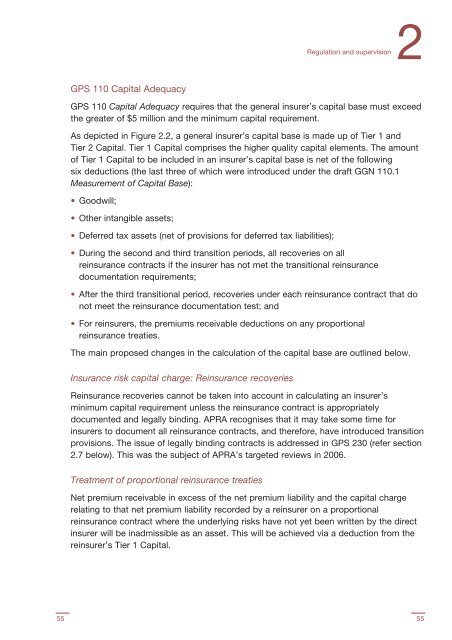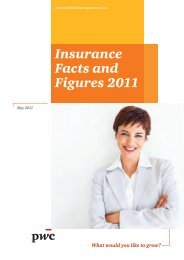Insurance facts and figures 2007 - PwC
Insurance facts and figures 2007 - PwC
Insurance facts and figures 2007 - PwC
Create successful ePaper yourself
Turn your PDF publications into a flip-book with our unique Google optimized e-Paper software.
Regulation <strong>and</strong> supervision<br />
2<br />
GPS 110 Capital Adequacy<br />
GPS 110 Capital Adequacy requires that the general insurer’s capital base must exceed<br />
the greater of $5 million <strong>and</strong> the minimum capital requirement.<br />
As depicted in Figure 2.2, a general insurer’s capital base is made up of Tier 1 <strong>and</strong><br />
Tier 2 Capital. Tier 1 Capital comprises the higher quality capital elements. The amount<br />
of Tier 1 Capital to be included in an insurer’s capital base is net of the following<br />
six deductions (the last three of which were introduced under the draft GGN 110.1<br />
Measurement of Capital Base):<br />
• Goodwill;<br />
• Other intangible assets;<br />
• Deferred tax assets (net of provisions for deferred tax liabilities);<br />
• During the second <strong>and</strong> third transition periods, all recoveries on all<br />
reinsurance contracts if the insurer has not met the transitional reinsurance<br />
documentation requirements;<br />
• After the third transitional period, recoveries under each reinsurance contract that do<br />
not meet the reinsurance documentation test; <strong>and</strong><br />
• For reinsurers, the premiums receivable deductions on any proportional<br />
reinsurance treaties.<br />
The main proposed changes in the calculation of the capital base are outlined below.<br />
<strong>Insurance</strong> risk capital charge: Reinsurance recoveries<br />
Reinsurance recoveries cannot be taken into account in calculating an insurer’s<br />
minimum capital requirement unless the reinsurance contract is appropriately<br />
documented <strong>and</strong> legally binding. APRA recognises that it may take some time for<br />
insurers to document all reinsurance contracts, <strong>and</strong> therefore, have introduced transition<br />
provisions. The issue of legally binding contracts is addressed in GPS 230 (refer section<br />
2.7 below). This was the subject of APRA’s targeted reviews in 2006.<br />
Treatment of proportional reinsurance treaties<br />
Net premium receivable in excess of the net premium liability <strong>and</strong> the capital charge<br />
relating to that net premium liability recorded by a reinsurer on a proportional<br />
reinsurance contract where the underlying risks have not yet been written by the direct<br />
insurer will be inadmissible as an asset. This will be achieved via a deduction from the<br />
reinsurer’s Tier 1 Capital.<br />
55<br />
55
















